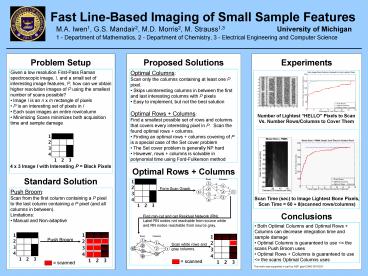Fast Line-Based Imaging of Small Sample Features PowerPoint PPT Presentation
1 / 1
Title: Fast Line-Based Imaging of Small Sample Features
1
Fast Line-Based Imaging of Small Sample Features
- M.A. Iwen1, G.S. Mandair2, M.D. Morris2, M.
Strauss1,3 University of Michigan - 1 - Department of Mathematics, 2 - Department of
Chemistry, 3 - Electrical Engineering and
Computer Science
Problem Setup
Proposed Solutions
Experiments
- Given a low resolution First-Pass Raman
spectroscopic image, I, and a small set of
interesting image features, P, how can we obtain
higher resolution images of P using the smallest
number of scans possible? - Image I is an n x m rectangle of pixels
- P is an interesting set of pixels in I
- Each scan images an entire row/column
- Minimizing Scans minimizes both acquisition time
and sample damage
- Optimal Columns
- Scan only the columns containing at least one P
pixel. - Skips uninteresting columns in between the first
and last interesting columns with P pixels - Easy to implement, but not the best solution
- Optimal Rows Columns
- Find a smallest possible set of rows and columns
that covers every interesting pixel in P. Scan
the found optimal rows columns. - Finding an optimal rows columns covering of P
is a special case of the Set cover problem - The Set cover problem is generally NP hard
- However, rows columns is solvable in
polynomial time using Ford-Fulkerson method
Number of Lightest HELLO Pixels to Scan Vs.
Number Rows/Columns to Cover Them
4 x 3 Image I with Interesting P Black Pixels
Optimal Rows Columns
Standard Solution
Form Scan Graph.
- Push Broom
- Scan from the first column containing a P pixel
to the last column containing a P pixel (and all
columns in between). - Limitations
- Manual and Non-adaptive
Scan Time (sec) to Image Lightest Bone
Pixels, Scan Time 60 8(scanned rows/columns)
Conclusions
Find min-cut and get Residual Network (RN). Label
RN nodes not reachable from source white and RN
nodes reachable from source gray.
- Both Optimal Columns and Optimal Rows Columns
can decrease integration time and sample damage - Optimal Columns is guaranteed to use lt the
scans Push Broom uses - Optimal Rows Columns is guaranteed to use lt
the scans Optimal Columns uses
Push Broom
Scan white rows and gray columns.
scanned
scanned
This work was supported in part by NSF grant
DMS-0510203

